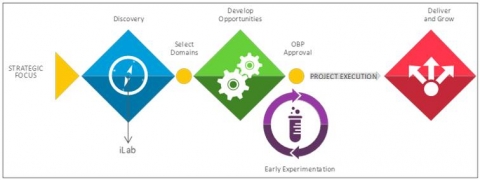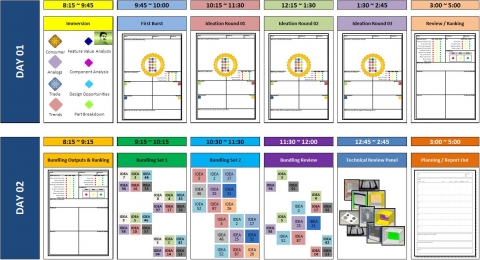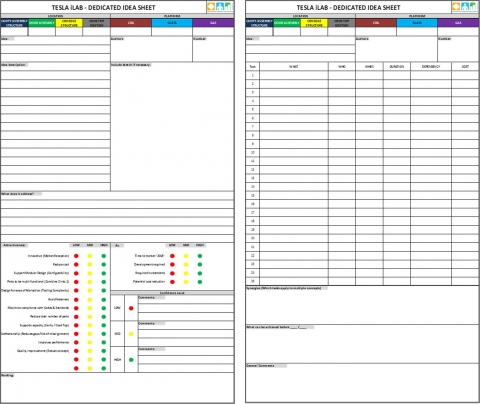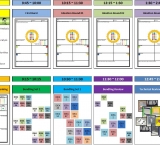This article was written as one of the requirements to obtain the Innovation Mentor Certification at CIMp. The CIMp program is part of iVia, The Way of Innovation™, founded by The University of Notre Dame, Whirlpool Corporation and Beacon Health System. Learn more at http://innovationcertification.nd.edu/
Do you want to generate hundreds of ideas in one hour using innovative techniques? Do you want to learn how to spark creativity with your teams? Do you want to engage your employees to think differently, generating ideas that can be the next big thing for your organization and your customers? Using experiences from Whirlpool Corporation this article offers ideas on how to break some of the rules or constraints mentally, challenging the status quo to generate ideas and solutions.
Whirlpool Corporation has more than 100 years of delivering customer value one moment at a time. We are the world’s leading global manufacturer and marketer of major home appliances, with $19 billion of sales in 2013 and with 100,000 employees operating in over 170 countries. Our company markets Whirlpool, Maytag, KitchenAid, Jenn-Air, Amana, Brastemp, Consul, Bauknecht and other major brands.
We earn the trust of consumers in nearly every country by focusing on what matters most to them. Our passion is to create products and solutions that delight our customers, improve their lives and support their best moments with family and friends. We create purposeful innovation that help keep homes running smoothly, enabling free time for the things that matter most in people’s lives. Our products incorporate the latest technology to make a positive impact today with an eye towards tomorrow.
Since 1999 we have embedded innovation as a core competency in our organization. Our Triple Diamond Innovation Process [Figure: 01] supports our global business in order to generate ideas, concepts and solutions that will resonate with our customers.
One of the key events in the Discovery Diamond that our i-managers facilitate is an Innovation Lab, or iLab for short. An iLab is a special environment, a protected space where we use different innovation tools and techniques that will enable the participants to unleash their creativity.
Figure 01: The Triple Diamond Innovation Process

Our goal is to create and launch innovative solutions into the market. When Whirlpool develops new solutions, from the simple to the very complex ones, we have to take all the rules, protocols, codes, specifications and policies into consideration before product launch. Like many companies Whirlpool has many rules to follow and we have to work with them all the time, no exceptions. Innovation gives us license to challenge rules or constraints without breaking them.
Let’s assume the following scenario. We ask engineers to develop a new solution, without considering all the rules that may limit the work. Our goal here is to spark their creativity without constraints, removing what could be. They might respond, “No way, how can we do that without considering all the rules during the product development process?”. If we are not in compliance the solution can’t move forward, it will be rejected.
How can we address a situation like the one described above and be more creative in our organization while using constraints to unleash idea generation? If you really want to come up with the next breakthrough you need to break, frame, change the rules and remove constraints in the beginning of the process. These early ideas and concepts might be crazy, wild, not technically or economically feasible, but they are the first step towards a solution that can be unique and relevant to our customers and our brands, create sustainable competitive advantage for our organization and bring value to our shareholders.
So, how can we do that? Breaking the rules? Really? Yes, let’s break, challenge or change some of them that are creating barriers to generate ideas. Remember, the iLab creates a protected space, where we strive to understand which ideas seem to be interesting to develop. We can apply the rules and constraints once the opportunities are identified, before launching them in the market.
The Global Innovation Team (GIT) at Whirlpool Corporation has a mission to support the strategic intent of all brands and product categories, i.e. Refrigeration, Cooking, Laundry, Cleaning, and Small Appliances. Our team hosts the global knowledge, content and tools that can be used throughout the innovation process. It represents the efforts of Whirlpool teams around the globe.
Most of the time the GIT works with the core business, on projects related to research & engineering, technology development, product development, cost and quality improvements, or any type of project. The Triple Diamond Innovation Process, is a powerful methodology that can be adapted and applied in a unique way, enabling the process to fit each opportunity, challenge or problem.
In 2012, we had a large project from the cooking category facing challenges in order to maximize value to our consumers. The project leader pulled the team together in order to request approval and release of resources from the category business team. The project team did a pre-assessment of the project and found that they couldn’t support one of the project KPI’s, “Key Performance Indicators,” because it was not aligned with costumer expectations. The project leader knew that they couldn’t go to the business team and request the resources that they needed until they had line of sight to address the gap. As part of the project-winning definition for this specific project, the new bill of material was required to be lower cost than the current one. The category was putting together a plan in order to be more competitive in the market, gaining share and providing new solutions for the costumers with the new project that would support their business strategy. The project team did everything they could on the preliminary analysis trying to address the gap, using all sorts of current engineering techniques and knowledge. But, unfortunately, it was not working enough and they were running out of time and ideas to support the next generation of products.
The project leader called me, the innovation manager, and explained the dilemma. We worked together to design and plan an iLab to address the gap challenge for the project using innovation tools. First it was important to understand the objectives and themes, people that were critical to join the project, the workshop format and secure the resources necessary for the activities. In the pre work before the iLab, we were also considering some other relevant inputs, such as consumer insights, market research, trends, analogs and trade. They are as one of the springboards for ideation.
Participants, with different knowledge and experiences, were identified for the iLab. We invited people from the cooking category and other categories as well. Having a diverse combination of participants is powerful and extremely important for the iLab’s success.
The first day of the iLab we designed in three different sessions in order to support idea generation. The second day was all about concepts generation to address the gap the project team had identified, [Figure: 02] shows typical iLab agenda for this type of workshop.
Figure 02: iLab Agenda

The day for the iLab had arrived. Everybody we had invited showed up and we started by welcoming our participants and introductions. It was time for the leadership to say thank you for their support and also share at a high level what was going on with the project and why they were there. Next, in more detail, the project leader started the presentation by sharing all the relevant information. This helped ground the participants as to why they were invited and set the stage with the iLab expectations. In the beginning of an iLab it is important to share all the information with everyone, since some of the participants are not familiar with the project or the pertinent information. The goal was to make sure that everybody was on the same page before kick-off the ideation sessions [Figure 03].
Figure 03: iLab kick-off at Whirlpool Innovation Garage
Additional information was available in order to support the participants in the Whirlpool Garage, which is a unique building designed to support creative thinking and collaboration. Information included product samples from our own brands, from the competitors, samples of key components and 3D exploded views for those not familiar with the product. It is good to remember that not everyone has the same level of product knowledge, especially for those outside the company, so the information is important to success. Keep in mind it is important to focus only on relevant information, don’t overload the iLab with non-relevant information, just bring the information that value for brainstorming to spark the participants’ creativity.
We broke the product down into four distinct subsystems:
- Cavity assembly and structures
- Door assembly
- Console structure
- Cook top and ignition
The space for the iLab was set up using four different locations [Figure 04], each one representing one of the sub-systems. The idea was to give the participants an opportunity to rotate during the ideation session within one hour, generating ideas for each one of them. Every fifteen minutes they were rotating to the next location “sub-system,” participants left their ideas at the station and moved to the next one. The next group of participants in the new location could start the brainstorming by building from the previous ideas that the other group left behind, continuing to generate more and more ideas.
Figure 04: iLab Space Set Up
One of the techniques that I use as an innovation manager is called “Creative Rule Breaking.” The participants like to work with this technique because it helps them to forget the rules and/or constraints. The first step is to create cards with rules and/or constraints that could be a bottleneck to generate ideas. The cards help participants with different backgrounds, by considering all the relevant knowledge and experiences in the iLab. Some of the rules or constraints used were: standards, codes, protocols, specifications, policies, materials, technologies, performance, design, craftsmanship, ergonomics, logistics, suppliers, manufacturing process, machines, equipments, tools, material handling, serviceability, skills and others, about thirty cards in all. Simulating the rotation process that would take place during the ideation session, the participants rotated every five minutes in order to create the cards, covering all the sub- systems that were representing the project.
The first step was completed and we had the cards. Next, I explain the dynamic about the ideation session using the Creative Rule Breaking technique. I ask the participants to flip the cards that were on the table in each of the stations, taking them one by one and trying to imagine an idea without that rule and/or constraint. As the ideas were being created, they were captured in the iLab Dedicated Idea Sheet [Figure 05]. The captured ideas were later used to prioritize the best and/or the more relevant ideas that could support the gap challenge the project team identified. With this technique we were able to develop around three hundred ideas in one hour.
Figure 05: iLab Dedicated Idea Sheet Front & Back

Normally an iLab takes two days. During the first day it is the time to share information about the opportunity, challenge or problem that we have. It is the time to run the ideation sessions using different tools and/or techniques, normally with three brainstorming sessions, it is possible to generate from five hundred to one thousand ideas in about three to four hours. Of course we recognize, not all of the ideas will support the gap and some are duplicated, at the end of the day it is time to select the best ones, making sure the ideas will be supporting your goals supported by innovation in the background, prioritize them to make sure that we have enough ideas that will support concept creation during the second day of the iLab. In our iLab, we were able to generate eight different concepts addressing the gap challenge. Mission accomplished? Not quite yet.
After the iLab, the project leader presented the outputs to the technical team. They reviewed all the ideas and concepts, ensuring they were not losing any opportunity. It was time to check feasibility at a high level and scope those eight concepts that could support the project team to address the gap challenge. The project team now had the information needed to support the winning definition and the tollgate. The project leader met with and presented the information to the business team, the project was approved and all necessary resources were released in order to move the project to the next phase. The work done at the iLab proved to be powerful, it was time to celebrate and it was time for the innovation manager to move to the next project.
Each iLab is different, we always learn lessons with each one of them. The Whirlpool teams’ effort around the globe provides the fuel to keep us moving forward. The innovation process is highly collaborative, driven by teams of people before, during and after an iLab.
Lessons learned from iLab’s we have conducted are:
- We used to create and give the constraints cards to the participants in the beginning of the Creative Rule Breaking session, the participants would be ready to go, the outcome from the session was good but not great. We changed this approach by asking the participants to build the cards with the rules and/or constraints. By using this approach, the participants interact with each other at the beginning of the process. This helped us realize the brainstorming was deeper and the quality of the ideas were much better.
- Prior to project approval, constraints can create problems for idea generation. This is especially true during the project winning definition process, where you and your team need to be very creative, generating unique and compelling solutions for your customers. Without this technique, you might be only optimizing the current solutions that you already have in the market. Freedom from constraints is important, as it helps you get to your goal.
- Sometimes constraints hinder creativity; but sometimes they actually help. Recognizing the difference is important for a project team. Once a project is approved and you get the resources you’re looking for, constraints are established for the project; they are the business targets and the product specifications. For instance, if something happened in the execution phase, you can’t just change the targets and move forward; you might be impacting the overall project financials, specifications and market launch. You have to deal with the situation and manage it carefully. You might need to set up another ilab, and utilize the constraints to help the idea generation to address the challenge.
- All the work that needs to be done is ultimately driven by teams of people, keeping in mind we are different from each other, with unique points of view. These differences are catalyst for contributing with inputs, ideas, perspectives and insights. Diversity is extremely important in this process. Invite people with different knowledge, experience levels, abilities, and distinct personalities. Don't forget to include people from outside your organization, all this mix will enrich and broaden the discussion, bringing the brainstorming or the use of any innovation tool or technique to a new level.
- Choose your iLab location wisely. Offsite space can remove participants from constraints and give them creative liberty. Disconnecting them from the day-to-day activities will help you accomplish your goals.
- When you actually sit down to do something creative, have an open mind. Brainstorm without judging or rejecting ideas, no matter how crazy they are, don’t break this rule.
Good Luck on your innovation journey.






You need to register in order to submit a comment.